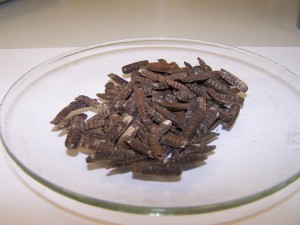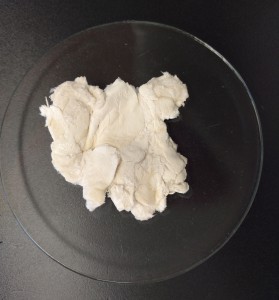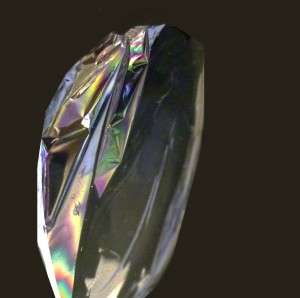Harmful chemicals are often used in textile processing. That is why the Fraunhofer Institute for Interfacial Engineering and Biotechnology IGB is researching harmless biobased alternatives. The Institute is working on utilizing side streams from the animal feed manufacture for the production of chitosan. The biopolymer is supposed to be used as a sizing agent in the processing of yarns or for the functionalization of textiles. Fraunhofer IGB will present its work at the ACHEMA trade fair from June 11 – 15 in Frankfurt am Main.

After pupae shed their skin, pupal exuviae remain as residual stream.
Chitin is a major component of insect skins and shells; large quantities of it result from the production of animal feed – ever since the feed industry has increasingly relied on insects as protein suppliers. Insects have the advantage that they reproduce quickly and can be bred cheaply on low-value substrates. This makes them a sustainable source of protein. So far, soya has been used for this purpose, but its cultivation is in direct competition with food production. Insect proteins have already been approved for poultry and pig feed. Since summer 2017, they can also be used as feeding stuff for fish. It is therefore to be expected that the use of insect proteins will become even more important in the future.
Insects supply feed proteins – the waste product chitin is as a valuable recyclable material

Chitosan, purified from insect skins.
The feed industry is focused on proteins, but the skins and shells of insects remain as a waste product. If they can also be utilized, this contributes to the sustainability and economic efficiency of the overall feed production. The potential is enormous: in the course of their development, the larvae of the insects shed their skins several times. The remaining molting products consist up to 40 percent of chitin.
In the joint project “ChitoTex”, the Fraunhofer Institute for Interfacial Engineering and Biotechnology IGB is investigating how insect chitin from animal feed production can be processed to supply biobased chemicals for textile processing. “For a long time now, we have been working on the development of processes for the recycling of residual and waste materials and therefore have the necessary expertise,” explains Dr. Susanne Zibek, who heads the research area of industrial biotechnology at the Institute.
Biopolymer chitosan as a substitute for environmentally harmful fluorocarbons

Chitosan is able to form films, which is important for its use as sizing agent.
At first, the Fraunhofer researchers have developed a purification process to separate chitin from further components of the insect skins such as proteins and minerals. “We are investigating various ways of deacetylating chitin to produce chitosan,” Zibek explains. “With an enzyme screening for example, we search for suitable enzymes for the deacetylation process”.
Due to its ability to form films, chitosan can be used as a sizing agent. This reduces friction in weaving machines and prevents the roughening or breaking of yarns in the weaving process; after that the sizing agent is either washed out again or remains on the yarn. In either case, biobased and natural alternatives to synthetic agents are beneficial for man and environment.
The second possible application is the functionalization of textiles, i.e. the finishing of textile fabrics with specific properties. “For example, we want to use the functional amino group to link hydrophobic molecules with the chitosan. Water-repellent properties can be achieved when applied to textiles.” Until now, environmentally harmful fluorocarbons are widely used for the hydrophobic finishing of outdoor textiles.
Presentation at the ACHEMA
At the ACHEMA from June 11–15, 2018 in Frankfurt am Main, Fraunhofer IGB will be available for further information and discussions at the Fraunhofer joint stand in Hall 9.2, Booth D66.
Source
Fraunhofer IGB, press release, 2018-06-04.
Supplier
Fraunhofer-Institut für Grenzflächen- und Bioverfahrenstechnik (IGB)
Share
Renewable Carbon News – Daily Newsletter
Subscribe to our daily email newsletter – the world's leading newsletter on renewable materials and chemicals










